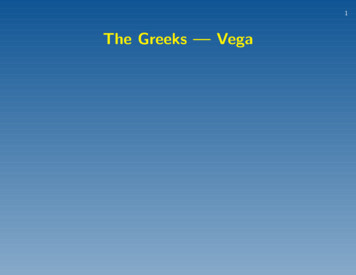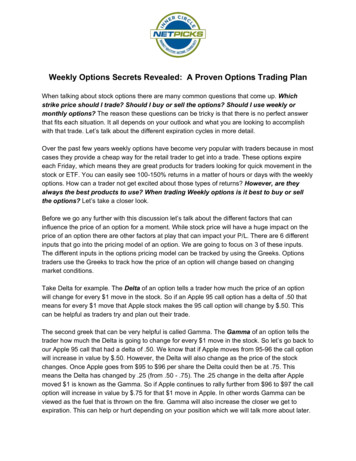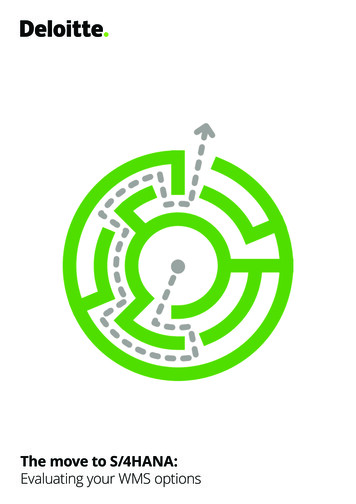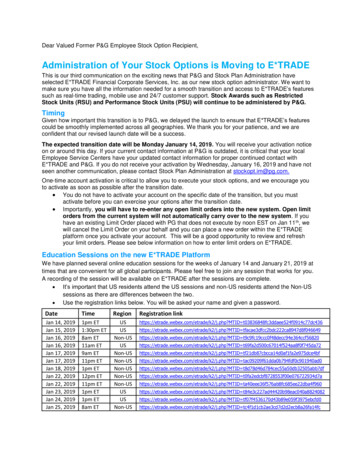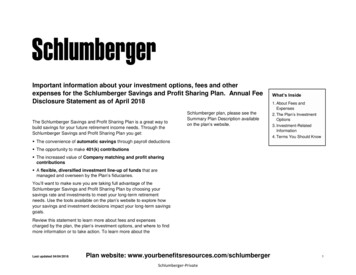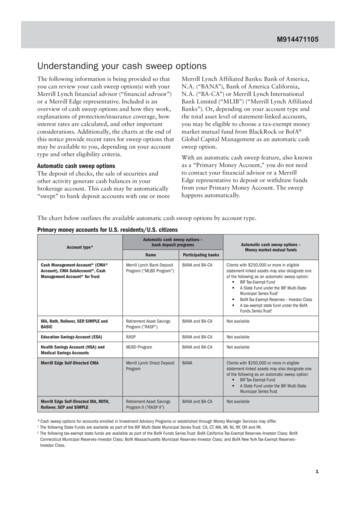
Transcription
Options GreeksBy John -greeks/default.aspThanks very much for downloading the printable version of this tutorial.As always, we welcome any feedback or pxTable Of Contents1) Option Greeks: Introduction2) Option Greeks: Options and Risk Parameters3) Option Greeks: Delta Risk and Reward4) Option Greeks: Vega Risk and Reward5) Option Greeks: Theta Risk and Reward6) Option Greeks: Gamma Risk and Reward7) Option Greeks: Position Greeks8) Option Greeks: Inter-Greeks Behavior9) Option Volatility: ConclusionIntroductionTrading options without an understanding of the Greeks - the essential riskmeasures and profit/loss guideposts in options strategies - is synonymous toflying a plane without the ability to read instruments.Unfortunately, many traders are not option strategy "instrument rated"; that is,they do not know how to read the Greeks when trading. This puts them at risk ofa fatal error, much like a pilot would experience flying in bad weather without thebenefit of a panel of instruments at his or her disposal.This tutorial is aimed at getting you instrument rated in options trading, tocontinue the analogy with piloting, so that you can handle any strategy scenarioand take the appropriate action to avoid losses or enhance gains. It will alsoprovide you with the tools necessary to determine the risk and reward potentialbefore lift off.When taking an option position or setting up an options strategy, there will be riskand potential reward from the following areas:(Page 1 of 30)Copyright 2010, Investopedia.com - All rights reserved.
Investopedia.com – the resource for investing and personal finance education. Price changeChanges in volatilityTime value decayIf you are an option buyer, then risk resides in a wrong-way price move, a fall inimplied volatility (IV) and decline in value on the option due to passage of time. Aseller of that option, on the other hand, faces risk with a wrong-way price move inthe opposite direction or a rise in IV, but not from time value decay. (Forbackground reading, see Reducing Risk With Options.)Interest rates, while used in option pricing models, generally don't play a role intypical strategy designs and outcomes, so they will remain left out of thediscussion at this point. In the next part of this tutorial, the role interest rates playin option valuation will be touched on in order to complete the overview of theGreeks.When any strategy is constructed, there are associated Delta, Vega and Thetapositions, as well as other position Greeks.When options are traded outright, or are combined, we can calculate positionGreeks (or net Greeks value) so that we can know how much risk and potentialreward resides in the strategy, whether it is a long put or call, or a complexstrategy like a strangle, butterfly spread or ratio spread, among many others.Typically, you should try to match your outlook on a market to the positionGreeks in a strategy so that if your outlook is correct you capitalize on favorablechanges in the strategy at every level of the Greeks. That is why knowing whatthe Greeks are telling you is so important.Greeks can be incorporated into strategy design at a precise level usingmathematical modeling and sophisticated software. But at a more basic level, theGreeks can be used as guideposts for where the risks and rewards can generallybe found.A simple example will help to demonstrate how not knowing the Greeks can leadto making bad choices when establishing options positions.If you open any basic options book for beginners, you'll typically find a calendarspread as an off-the-shelf, plain vanilla approach. If you have a neutral outlookon a stock or futures market, the calendar spread can be a good choice forstrategists.However, hidden in the calendar spread is a volatility risk dimension rarelyThis tutorial can be found at: ks/default.asp(Page 2 of 30)Copyright 2010, Investopedia.com - All rights reserved.
Investopedia.com – the resource for investing and personal finance education.highlighted in beginner books. If you sell an at-the-money front month option andbuy an at-the-money back month option (standard calendar spread), the Vegavalues on these options will net out a positive position Vega (long volatility).That means that if implied volatility falls, you will experience a loss, assumingother things remain the same. What you will find is that a small change in impliedvolatility (either up or down) can lead to unrealized gains or losses, respectively,that make the potential profit from the original differential time value decay on thecalendar spread seem trivial.Most beginner books regarding calendar spreads only draw your attention to theposition Theta; this example demonstrates the importance of a combination ofGreeks in any analysis.When a pilot sees his or her horizon indicator and correctly interprets it, then it ispossible to keep the plane flying level even when flying through clouds or atnight. Likewise, watching Vega and other Greeks can help keep optionsstrategists from suffering a sudden dive in equity resulting from not knowingwhere they are in relation to the risk horizons in options trading - a dive that theymay not be able to pull out of before it is too late.For background reading, see Using the Greeks to Understand Options.Options and Risk ParametersThis segment of the options Greeks tutorial will summarize the key Greeks andtheir roles in the determination of risk and reward in options trading. Whether youtrade options on futures or options on equities and ETFs, these concepts aretransferable, so this tutorial will help all new and experienced options traders getup to speed.There are five essential Greeks, and a sixth that is sometimes used by traders.DeltaDelta for individual options, and position Delta for strategies involvingcombinations of positions, are measures of risk from a move of the underlyingprice. For example, if you buy an at-the-money call or put, it will have a Delta ofapproximately 0.5, meaning that if the underlying stock price moves 1 point, theoption price will change by 0.5 points (all other things remaining the same). If theprice moves up, the call will increase by 0.5 points and the put will decrease by0.5 points. While a 0.5 Delta is for options at-the-money, the range of Deltavalues will run from 0 to 1.0 (1.0 being a long stock equivalent position) and fromThis tutorial can be found at: ks/default.asp(Page 3 of 30)Copyright 2010, Investopedia.com - All rights reserved.
Investopedia.com – the resource for investing and personal finance education.-1.0 to 0 for puts (with -1.0 being an equivalent short stock position).In the next part of this tutorial, this simple concept will be expanded to includepositive and negative position Delta (where individual Deltas of options aremerged in a combination strategy) in most of the popular options strategies.VegaWhen any position is taken in options, not only is there risk from changes in theunderlying but there is risk from changes in implied volatility. Vega is themeasure of that risk. When the underlying changes, or even if it does not in somecases, implied volatility levels may change. Whether large or small, any changein the levels of implied volatility will have an impact on unrealized profit/loss in astrategy. Some strategies are long volatility and others are short volatility, whilesome can be constructed to be neutral volatility. For example, a put that ispurchased is long volatility, which means the value increases when volatilityincreases and falls when volatility drops (assuming the underlying price remainsthe same). Conversely, a put that is sold (naked) is short volatility (the positionloses value if the volatility increases). When a strategy is long volatility, it has apositive position Vega value and when short volatility, its position Vega isnegative. When the volatility risk has been neutralized, position Vega will beneither positive nor negative.ThetaTheta is a measure of the rate of time premium decay and it is always negative(leaving position Theta aside for now). Anybody who has purchased an optionknows what Theta is, since it is one of the most difficult hurdles to surmount forbuyers. As soon as you own an option (a wasting asset), the clock starts ticking,and with each tick the amount of time value remaining on the option decreases,other things remaining the same. Owners of these wasting assets take theposition because they believe the underlying stock or futures will make a movequick enough to put a profit on the option position before the clock has ticked toolong. In other words, Delta beats Theta and the trade can be closed profitably.When Theta beats Delta, the seller of the option would show gains. This tug ofwar between Delta and Theta characterizes the experience of many traders,whether long (purchasers) or short (sellers) of options.GammaDelta measures the change in price of an option resulting from the change in theunderlying price. However, Delta is not a constant. When the underlying movesso does the Delta value on any option. This rate of change of Delta resulting frommovement of the underlying is known as Gamma. And Gamma is largest foroptions that are at-the-money, while smallest for those options that are deepestin- and out-of-the-money. Gammas that get too big are risky for traders, but theyThis tutorial can be found at: ks/default.asp(Page 4 of 30)Copyright 2010, Investopedia.com - All rights reserved.
Investopedia.com – the resource for investing and personal finance education.also hold potential for large-size gains. Gammas can get very large as expirationnears, particularly on the last trading day for near-the-money options.RhoRho is a risk measure related to changes in interest rates. Since the interest raterisk is generally of a trivial nature for most strategists (the risk free interest ratedoes not make large enough changes in the time frame of most optionsstrategies), it will not be dealt with at length in this tutorial.When interest rates rise, call prices will rise and put prices will fall. Just thereverse occurs when interest rates fall. Rho is a risk measure that tells strategistsby how much call and put prices change as a result of the rise or fall in interestrates. The Rho values for in-the-money options will be largest due to arbitrageactivity with such options. Arbitragers are willing to pay more for call options andless for put options when interest rates rise because of the interest earningspotential on short sales made to hedge long calls and opportunity costs of notearning that interest.Positive for calls and negative for puts, the Rho values will be larger for longdated options and negligible for short-dated ones. Strategists who use long-termequity anticipation securities (LEAPS) should take into account Rho since overlonger time frames the interest rate share of an option's value is more significant.Position If Positive Value If Negative ValueGreeks ( )(-)DeltaLong theUnderlyingVegaLong VolatilityShort Volatility(Gains if IV Rises) (Gains if IV Falls)ThetaGains From TimeValue DecayGamma Net LongPuts/CallsShort theUnderlyingLoses From TimeValue DecayNet ShortPuts/CallsRhoCalls Increase in Put Decrease inValue W/ Interest Value W/ InterestRates RiseRate RiseFigure 1: Greeks and what they tell us aboutpotential changes in options valuationOne other Greek is known as the Gamma of the Gamma, which measures therate of change of the rate of change of Delta. Not often used by strategists, itmay become an important risk measure of extremely volatile commodities orThis tutorial can be found at: ks/default.asp(Page 5 of 30)Copyright 2010, Investopedia.com - All rights reserved.
Investopedia.com – the resource for investing and personal finance education.stocks, which have potential for large changes in Delta.In terms of position Greeks, a strategy can have a positive or negative value. Insubsequent tutorial segments covering each of the Greeks, the positive andnegative position values for each strategy will be identified and related topotential risk and reward scenarios. Figure 1 presents a summary of theessential characteristics of the Greeks in terms of what they tell us aboutpotential changes in options valuation. For example, a long (positive) Vegaposition will experience gains from a rise in volatility, and a short (negative) Deltaposition will benefit from a decline in the underlying, other things remaining thesame.Last, by altering ratios of options in a complex strategy (among otheradjustments), a strategist can neutralize risk from the Greeks. However, thereare limitations to such an approach, which will be explored in subsequent parts ofthis tutorial. (For more, see Getting To Know The Greeks.)ConclusionA summary of the risk measures known as the Greeks is presented, noting howeach expresses the expected changes in an option's price resulting fromchanges in the underlying (Delta), volatility (Vega), time value decay (Theta),interest rates (Rho) and the rate of change of Delta (Gamma). It was also shownwhat it means to have positive or negative position Greeks.Delta Risk and RewardPerhaps the most familiar Greek is Delta, which measures option sensitivity to achange in the price of the underlying. Delta is most likely the first risk parameterencountered by a trader of outright positions. When contemplating how far out-ofthe-money to buy a put option, for example, a trader will want to know what thetrade-off is between paying less for that option the farther it is out-of-the-moneyin exchange for lower Delta at these more distant strikes. The eye can easilyscan the strike chain to see how the prices of the options change as you geteither deeper out-of-the-money or deeper in-the-money, which is a proxy formeasuring Delta.As can be seen in Figure 2containing IBM options, the lower the price of theoption, the lower its Delta. The left hand green shaded area shows the strikes(calls on top ranging from 130 to 90 strikes, and puts below ranging from 130 to95). To the right of the green shaded area is a column containing option prices,which is beside a middle column showing the Deltas (125, 110 and 100 call strikeDeltas are circled). Finally, the right-hand column in the white area is timeThis tutorial can be found at: ks/default.asp(Page 6 of 30)Copyright 2010, Investopedia.com - All rights reserved.
Investopedia.com – the resource for investing and personal finance education.premium on the options.Figure 2: IBM Delta values across time and along strike chain as takenon Dec. 28, 2007. Months in the green-shaded area across top andstrikes in green-shaded area along left side. The price of IBM whenthese values were taken was at 110.09 at close on Friday, Dec. 28,2007.Source: OptionVue 5 Options Analysis SoftwareCircled items in Figure 2 indicate Delta values for select IBM call strikes. Forexample, the first set of circled values (January call options) is 90.2 (100 callstrike), 52.9 (110 call strike) and 2.27 (125 call strike). The highest Delta value isfor the in-the-money 100 call and the lowest is for the far out-of-the-money 125call. At the money is indicated with the small arrow to the right of the 110 callstrike (green shaded area). Note that the Delta values rise as the strikes movefrom deep out of the money to deep in the money.One interpretation of Delta used by traders is to read the value as a probabilitynumber - the chance of the option expiring in-the-money. For instance, the atthe-money 110 call with a Delta of 52.9 in this case suggests that the 110 callhas a 52.9% probability of expiring in-the-money. Of course, underlying thisinterpretation is the assumption that prices follow a log-normal distribution(essentially daily price changes are merely a coin flip – heads up or tails down).Of course, in short- and even medium-term time frames, stocks or futures mayhave a significant trend to them, which would alter the 50-50 coin flip story.Delta values on options strikes depend on two key factors – time remaining untilexpiration and strike price relative to the underlying. Looking again at Figure 2, itis possible to see the effect of time remaining on the options. Figure 2 providesThis tutorial can be found at: ks/default.asp(Page 7 of 30)Copyright 2010, Investopedia.com - All rights reserved.
Investopedia.com – the resource for investing and personal finance education.Delta values for January, February, April and July options months. The yellowhighlighted area is for the 110 call option strike across months, which is the atthe-money strike. As is clear from the Delta values along the yellow bar (i.e., allthe at-the-money options), Delta increases slightly as the option acquires moretime on it. For example, the 110 call option for January 2008 has a Delta of 52.9while the July 2008 call option has a Delta value of 56.2.These differences, however, are small compared to the differences in Deltas onoptions across these months that are deep in-the-money and deep out-of-themoney. The out-of-the-money 125 call options, for example, have a Delta rangefrom 2.27 (January) to 29.4 (July). And the 100 in-the-money call options haveDeltas ranging from 90.2 to 72.8 for the same months. Note that the in-themoney Deltas fall with greater time remaining while the out-of-the-money calloptions rise with more time remaining on them.The put Deltas, meanwhile, are also shown in Figure 2 (but not highlighted) justbelow the calls. They all have negative signs since put Deltas are alwaysnegative (even though position Delta will depend on whether you buy or sell theputs). The same relationships between strikes and time remaining apply equallyto the puts as they do to the calls, so there is no need to repeat the analysis forthe puts on IBM. As for position Deltas, long puts have negative position Delta(i.e., short the market) and short puts positive position Delta (i.e., long themarket).StrategiesPosition DeltaLong CallPositiveShort CallNegativeLong PutNegativeShort PutPositiveLong StraddleNeutralShort StraddleNeutralLong StrangleNeutralShort StrangleNeutralPut Credit SpreadPositivePut Debit SpreadNegativeCall Credit SpreadNegativeCall Debit SpreadPositiveCall Ratio SpreadNegativeThis tutorial can be found at: ks/default.asp(Page 8 of 30)Copyright 2010, Investopedia.com - All rights reserved.
Investopedia.com – the resource for investing and personal finance education.Put Ratio SpreadPositiveCall Back SpreadPositivePut Back SpreadNegativeCalendar Spread(Near) NeutralCovered Call WriteNegativeCovered Put WritePositiveFigure 3: Delta risk and common strategies foroptions. The position Deltas in this tablerepresent standard strategy setups. Long andshort straddles and strangles assume equalDelta valueson the strikes.A summary of position Deltas for many popular strategies is seen in Figure 3. Afew assumptions were made for several of the strategies to allow for easycategorization. For instance, the call and put ratio spreads assume that thespreads are out-of-the-money and have smaller Delta on the long leg comparedwith the position Delta on the short legs (i.e., 1 long leg and 2 short legs).Additionally, the calendar spread is at-the-money. And the straddles andstrangles are constructed with Deltas on the puts and calls being the same.ConclusionThe options Greek known as Delta is explained, providing a look at Deltashorizontally across time and vertically along strike chains for different months.The key differences in Deltas inside this matrix of strike prices are highlighted.Finally, position Deltas for popular strategies are presented in table format.For more insight, see Going Beyond Simple Delta: Understanding Position Deltaand Capturing Profits with Position-Delta Neutral Trading.Vega Risk and RewardWhen an option is purchased or option strategy established, any price movementof the underlying depending on position Delta will have an impact (unless it isDelta neutral) on the outcome in terms of profit and loss, as was seen in theprevious segment of this tutorial. But another important risk/reward dimensionexists, usually lurking in the background, which is known as Vega. Vegameasures the risk of gain or loss resulting from changes in volatility.This tutorial can be found at: ks/default.asp(Page 9 of 30)Copyright 2010, Investopedia.com - All rights reserved.
Investopedia.com – the resource for investing and personal finance education.Figure 4: IBM Vega values across time and along stirke chains.Values taken on Dec. 29, 2007 with price of underlying at 110.09.Source: OptionVue 5 Options Analysis SoftwareFigure 4 shows all Vega values as positive because they are not here reflectingposition Vegas. Vega for all options is always a positive number because optionsincrease in value when volatility increases and decrease in value when volatilitydeclines. When position Vegas are generated, however, positive and negativesigns appear, which are not shown in Figure 4. When a strategist takes a positionselling or buying an option, this will result in either a negative sign (for selling) orpositive sign (for buying), and the position Vega will depend on net Vegas.What should be obvious from Figure 4 and from the other Vega values is thatVega will be larger or smaller depending on the size of time premium on theoptions. Time values are viewable in the right-hand data column in each month'soptions window. For the January 110, 105 and 100 calls, for instance, the timevalues are and 3.01, 1.27 and 0.49 respectively. These higher time premiumvalues are associated with higher Vega values. The 110 strike has Vega of 10.5,the 105 strike a Vega of 8.07 and the 100 a Vega of 4.52.Any other sequence of time value and Vega values in any of the months willshow this same pattern. Vega values will be higher on options that have moredistant expiration dates . As you can see in Figure 4, for example, the at-themoney call option Vegas (highlighted in yellow), go from 10.5 (January) to 32.1(July). Clearly, an at-the-money July call option has much greater Vega risk thana January at-the-money call option. This means that LEAPS options, which havesometimes two to three years of time value, will carry very large Vegas and aresubject to major risk (and potential reward) from changes in implied volatility. Buta distant option with little time premium because it is very far out of the moneymay have less Vega risk. (For more, see ABCs Of Option Volatility.)This tutorial can be found at: ks/default.asp(Page 10 of 30)Copyright 2010, Investopedia.com - All rights reserved.
Investopedia.com – the resource for investing and personal finance education.The premium for each of these options in the bull call spread is indicated at theleft of the yellow highlighted Vega values. You would pay 10.58 ( 1,058) andcollect 6.36 ( 636) for the 100 and 105 January calls, respectively. Since theseare in-the-money options, most of the value is intrinsic (IBM price at thissnapshot is 110.09).Depending upon whether the strategy employed is Vega long or short, therelationship between price movement and implied volatility can lead to eithergains or losses for the options strategist. Let's take a look at a simple example toillustrate this dynamic before exploring some more advanced concepts related toVega and position Vega.The implied volatility (IV) of options on the S&P 500 index is inversely related tomovement of the underlying index. If the market has been bearish, typically IVlevels will trend higher and vice versa. Therefore, when a call option is purchasednear market bottoms (when IV is at a relatively high level), it is exposed to anegative (inverse) price-volatility relationship. Buying a call, or any option for thatmatter, puts you on the long side of Vega (long Vega), which means if IVdeclines, other things remaining the same, the option strategy will lose.In this example, however, other things don't remain the same, since the market isgoing to make a bottom and trade higher off that bottom. Delta has a positiveimpact (the position is long Delta), but this will be offset to the degree Vega, longposition Vega and volatility decline. If the market does a V-like bottom, there islittle risk from Theta, or time value decay, since the market moves fast and far,leaving little room for Theta to pose any risk.There are some exceptions, such as bullish call spreads that are in-the-money,or partially in-the-money. For example, if we create a bull call spread to play amarket rebound, it would be better from the Vega risk perspective to select a longcall that has a smaller Vega value than the one we sell against it. For example,looking at Figure 5, in January, the purchase of an IBM 100 in that month will addlong (positive) 4.52 Vegas (here meaning that for every point fall in impliedvolatility, the option will lose 4.52). Then if we sell a 105 call in the same month,we add 8.07 short (negative) Vegas, leaving a position Vega of -3.55 (thedifference between the two) for this bull call spread.Returning to the construction of this in-the-money bull call spread, if the spread ismoved out-of-the-money, the position Vega will change from net short to netlong. As you can see in Figure 5, if an at-the-money strike is bought for 3.10( 310), it adds 10.5 long Vegas. If the 120 January call is sold for 0.30 ( 30) tocomplete the construction of this at- to out-of-the-money bull call spread, 4.33short Vegas are added (remember sold options always have position Vegas thatThis tutorial can be found at: ks/default.asp(Page 11 of 30)Copyright 2010, Investopedia.com - All rights reserved.
Investopedia.com – the resource for investing and personal finance education.are negative, meaning they benefit from a fall in volatility), leaving a positionVega on the spread of 6.17 (10.5 - 4.33 6.17).With this spread, a rebound in IBM with an associated collapse in impliedvolatility levels (remember most big-cap stocks and major averages have aninverse price-implied volatility relationship), would be a negative for this trade,undermining unrealized gains from being long position Delta. We would be betteroff using an in-the-money bull call spread because it gets us long Delta and shortVega.Figure 5: IBM Vega values on each strike of in-the-money bull callspread. Position Vega is positive with -8.07 negative Vegas and 4.52positive Vegas, leaving a net Vega of -3.55. Values taken on Dec. 29,2007, with IBM at 110.09.Source: OptionVue 5 Options Analysis SoftwareIf playing a market bottom, novice traders might buy a call or bull call spread.Assuming Theta is not a factor here, in a long call position there would be gainsresulting from the position's positive Delta, but losses due to having long Vega.Unless we know the exact Vega and Delta values and the size of the drop inimplied volatility associated with the price move (typically large inverserelationship at market bottom reversals), we will not know ahead of time exactlyhow much will be gained or lost on this position. Nevertheless, we know the factthat rebound reversal rallies typically generate large implied volatility decline, sothis clearly is not the best approach.Had the trader purchased a call ahead of the rebound and got the directional callcorrect, a drop in IV would have erased gains from being long Delta. Not a happyoutcome, but an experience that should alert a trader to this potential pitfall.A put option buyer would suffer a worse fate. Since the premium on the option isThis tutorial can be found at: ks/default.asp(Page 12 of 30)Copyright 2010, Investopedia.com - All rights reserved.
Investopedia.com – the resource for investing and personal finance education.inflated due to raised levels of IV, a buyer of puts would suffer from being on thewrong side of Delta and Vega given a rebound reversal rally. Buying anexpensive put and having the market go against you results in a double dose oftrouble – being short Delta and long Vega when the market goes up and IVcomes crashing down. Clearly, the best of all possible positions here is a longDelta and short Vega play, which at the simplest level would be a short put. Butthis would hurt doubly if the market continues to go lower. A more conservativeplay would be an in-the-money bull call spread as discussed earlier.Figure 6 contains the popular options strategies and associated position Vegas.However, as can be seen from the comparison of an in-the-money bull callspread and an at- to out-of-the-money bull call spread, where spreads areplaced, not just the type of spread, can alter the position Vegas, just as it canalter other position Greeks. Therefore, Figure 6 should not be taken as the finalword on the position Vegas. It merely provides position Vegas for some standardstrategy setups, not all possible strike selection variations of each strategy.StrategiesPosition VegaSignsLong CallPositiveShort CallNegativeLong PutPositiveShort PutNegativeLong StraddlePositiveShort StraddleNegativeLong StranglePositiveShort StrangleNegativePut Credit SpreadNegativePut Debit SpreadPositiveCall Credit SpreadPositiveCall Debit SpreadNegativeCall Ratio SpreadNegativePut Ratio SpreadNegativeCalendar SpreadPositiveCovered Call WriteNegativeCovered Put WriteNegativeFigure 6: Position Vega signs for commonThis tutorial can be found at: http://www.investo
Trading options without an understanding of the Greeks - the essential risk . highlighted in beginner books. If you sell an at-the-money front month option and . (the risk free interest rate does not ma
